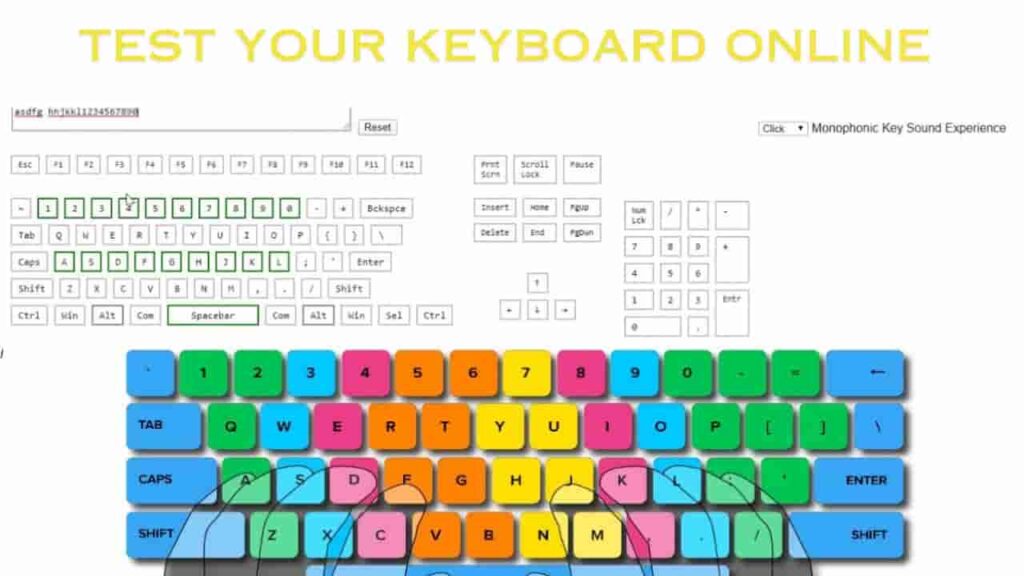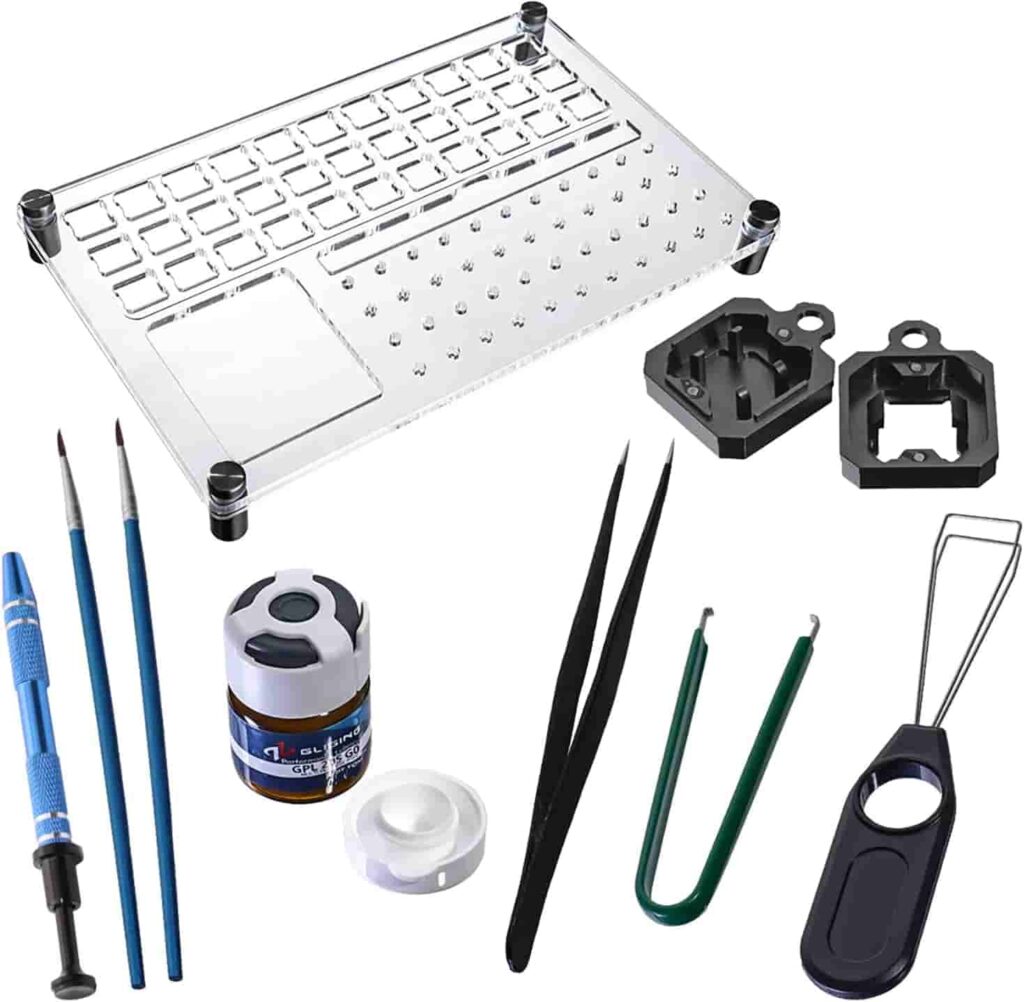How to Use a Keyboard Tester? Fixing Your Keyboard Issues
Updated: 09/12/2023
193

From typing out essential emails to gaming adventures and endless social media scrolling, a functional keyboard is a crucial tool that ensures seamless communication and efficient work. However, we’ve all experienced the frustration of a malfunctioning keyboard. Whether it’s unresponsive keys, random characters appearing on the screen, or sudden key ghosting, these issues can throw us off balance and disrupt our productivity.
Are you struggling with unresponsive keys or ghosting on your mechanical keyboard?
Fear not! There’s a powerful tool at your disposal that can help identify and fix those annoying issues – the Keyboard Tester. In this blog post, we will guide you through making the most out of this online keyboard test tool, ensuring a buttery-smooth typing experience each time you sit at your keyboard.
Understanding the Keyboard Tester

Before we dive into the nitty-gritty of troubleshooting with a key test, let’s take a moment to understand what it is and why it’s such a valuable tool.
A Mechanical keyboard tester is a tool designed to diagnose and identify problems with your keyboard. It allows you to check if all the keys on your keyboard are functioning properly. This is especially useful when you encounter issues such as unresponsive keys, stuck keys, or repeat key characters.
A Mac keyboard tester is essential for anyone who relies on a desktop keyboard for work or personal use. Using a keyboard button tester, you can quickly identify any issues with your mechanical keyboard and take appropriate action to fix them. This can save you time and frustration in the long run, as a dysfunctional keyboard can significantly impact your productivity.
Key benefits of using a keyboard tester include:
- A key test involves systematically testing each keyboard key to identify malfunctions.
- The ability to identify and diagnose keyboard issues accurately
- Evaluation of individual key functionality and responsiveness
- Detection of key ghosting or simultaneous key press problems
- Easy identification of incorrect key outputs
You can choose between software-based keyboard tests online and hardware- based on your preferences and needs. Let’s take a closer look at each of them.
How Does a Keyboard Latency Tester Work?

A keyboard tester sends signals to your keyboard and analyzes the response. It evaluates each key individually to check if it is functioning as intended.
There are two main types of keyboard testers: online and offline.
Online keyboard testers are websites or web applications that allow you to test your keyboard from any computer with an internet connection. To use an online keyboard tester, open the website and press the keys. The website will display a virtual keyboard highlighting what key I am pressing. If a key is not working, it will not be highlighted.
Offline keyboard testers are programs that you can install on your computer. Offline keyboard testers typically offer more features than keyboard testing online, such as the ability to individual key checkers, test for ghosting, and test for key rollover.
Identifying Common Keyboard Issues with a Keyboard Tester
Now that we understand the benefits of using a laptop keyboard tester, it’s time to look at the most common keyboard issues you might encounter. Here are a few of them:
1. Unresponsive Keys
Have you ever pressed a key repeatedly, only to find nothing happened? This issue of unresponsive keys can be incredibly frustrating and can severely hinder your typing speed. Using a keyboard tester portable, you can identify whether the problem lies with specific keys or a broader issue affecting the entire keyboard.
2. Key Ghosting

Key ghosting occurs when you press buttons simultaneously, but the keyboard fails to register all of them. For example, you might press “W,” “A,” and “S” together, but only “W” and “A” register on your screen. A keyboard tester for a laptop can help you identify if your laptop keyboard has this particular issue, allowing you to take appropriate action.
3. Incorrect Key Outputs
Have you ever noticed strange characters appearing on your screen when you press certain keys? This issue of incorrect key outputs can result from hardware or software problems. By running tests on a keyboard tester, you can determine if certain key responses consistently produce incorrect outputs, ultimately pinpointing the root cause of the problem.
Step-by-Step Guide: Using a Keyboard Tester for Keyboard Troubleshooting
Now that you’re familiar with the common keyboard issues a tester can help identify, let’s walk through the process of using a keyboard tester to troubleshoot your keyboard problems. We’ll explore both software-based and hardware-based keyboard function tests to ensure you have all the tools.
Software-based Keyboard Testers
- Installing a software-based keyboard tester on your computer:
To get started, search for reliable and reputable keyboard testing software online. Many options are available. Download and install the software based on the provided instructions.
- Understanding the user interface and available features:
Launch the keyboard tester software and familiarize yourself with the user interface. Most keyboard testers offer various testing options and features, including individual key testing, simultaneous key pressing, and custom key mapping. Take some time to explore these features and understand how they can help diagnose your keyboard issues.
- Exploring the various testing options:
Select the appropriate testing option depending on the nature of your keyboard problem. If you suspect that specific keys are malfunctioning, use the individual key testing mode to determine the exact keys causing trouble. If you’ve been experiencing key ghosting, try the simultaneous key-pressing feature to identify which keys are affected.
- Analyzing the results to identify problem areas:
Once you’ve performed the test, the software will display the results of each key’s functionality. Carefully analyze the data presented to determine any patterns or consistent issues. This will help you identify problem areas and decide on the best action for repairs or replacements.
- Taking corrective actions or seeking professional assistance:
Based on the test results, you can either attempt to fix the issues yourself (if it’s a simple problem like loose connections) or consult a professional technician for further assistance. Whatever the case, the results obtained from the software-based keyboard tester will guide you in making informed decisions for resolving your keyboard issues.
Hardware-based Keyboard Testers
- Introduction to hardware-based keyboard testers:
Hardware-based keyboard testers, also known as keycaps, offer another approach to diagnose and troubleshoot keyboard problems. These devices are designed to be physically connected to your keyboard and can provide even more accurate results than software-based alternatives.
- Connecting your keyboard to the hardware tester correctly:
Follow the manufacturer’s instructions to properly connect your keyboard to the hardware-based tester. This may involve unplugging your keyboard from your computer and attaching it to the tester using the provided cables or connectors.
- Following the instructions for running tests and interpreting the results:
Once your keyboard is connected to the hardware tester, the device will guide you through the steps required to run tests. Usually, this involves pressing specific keys or combinations while observing the results on the tester’s screen or LED display. Pay close attention to any abnormal readings or key malfunctions.
- Analyzing the data provided by the hardware tester:
After completing the tests, carefully review the data provided by the hardware tester. This information will help you pinpoint the exact keys or areas of your keyboard experiencing issues. Depending on the tester model, it may include visual representations of key presses, voltage measurements, or other diagnostic data.
- Suggesting appropriate solutions based on the test outcomes:
Based on the test results and your level of expertise, you can decide on the most suitable solution to address the keyboard problems. Sometimes, it may be as simple as cleaning the affected keys or adjusting the connections. If the issues appear more complex, consider seeking assistance from a professional keyboard repair service or replacing the keyboard altogether.
Keyboard Testing for Specific Devices
Testing your keyboard is essential in ensuring your computer is functioning properly. Various methods are available for testing your keyboard, depending on the type of device you are using.
Chromebook

To test your keyboard on a Chromebook, you can use the following methods:
- On-screen keyboard: Open the Settings app and select “Language & Input.” Under “Keyboard,” click on “On-screen keyboard.” The on-screen keyboard will appear on the screen. Press each key on your physical keyboard to see if it registers on the on-screen keyboard.
- Keyboard tester app: Several keyboard key tester apps are available for Chrome OS. One popular option is Keyboard Tester Online. This app will allow you to test keyboard keys individually and key combinations.
Online Keyboards
To test an online keyboard, you can use the following methods:
- Keyboard tester website: There are several keyboard testing websites available. One popular option is Bestkeyboardtester.com. This website will allow you to test each key on your keyboard individually and key combinations.
- Virtual keyboard: Many websites and applications offer a virtual keyboard that you can use to input text. To test your keyboard with a virtual keyboard, type text into the virtual keyboard and see if the text appears correctly in the application.
Pro Tips for Efficient Keyboard Testing Website and Troubleshooting
While the above steps should set you on the path to successfully identifying and resolving your keyboard issues, here are a few additional tips to ensure efficient testing and troubleshooting:
- Proper cleaning and maintenance: Regularly clean your keyboard to prevent dust and debris buildup. This simple step can help prevent many common keyboard issues.
- Utilizing keyboard shortcuts: Take advantage of keyboard shortcuts provided by the testing software or your computer’s operating system. These shortcuts can speed up testing and help detect issues more rapidly.
- Seeking online resources and forums: Online communities and forums are treasure troves of information. When faced with a challenging keyboard issue, consult these resources for user experiences, specific resolutions, and expert advice.
- Keeping a record of test results: Maintain a digital or physical logbook of your keyboard test results. This record will help you track the progress of your troubleshooting journey and serve as a handy reference for future keyboard issues.
Conclusion:
In conclusion, a keyboard tester is an invaluable tool for anyone who relies on a keyboard for work or personal use. By utilizing a keyboard tester, you can quickly identify and resolve any issues with your keyboard, ensuring optimal performance and productivity. Take the time to test your keyboard regularly and address any problems promptly. Remember, a well-functioning keyboard is essential for smooth and efficient work.
So, visit our website to check your keyboard or for keyboard testing, and keep your keyboard in top shape.
What is a tester keyboard?
A tester keyboard, also known as a keyboard tester or keyboard checker, is a tool designed to diagnose and identify problems with your computer keyboard. It allows you to test each key on your keyboard to see if it is functioning properly. This can be helpful if you are experiencing problems such as unresponsive keys, sticky keys, or repeating characters.
What are the benefits of using a keyboard tester?
There are several benefits to using a keyboard tester, including:
- Identifying keyboard problems quickly and easily
- Testing individual keys to pinpoint the problem
- Detecting key ghosting or simultaneous key press problems
- Identifying incorrect key outputs
- Saving time and frustration by avoiding unnecessary repairs or replacements
How do I use a software-based keyboard tester?
There are many free software-based keyboard testers available online. To use one, follow these steps:
- Open your web browser and search for “keyboard tester.”
- Click on one of the results to open the keyboard tester website.
- Press each key on your keyboard to see if it registers on the website.
- If a key does not register, it is likely malfunctioning.
How do I use a hardware-based keyboard tester?
Hardware-based keyboard testers are physical devices that you connect to your computer. They are typically more accurate than software-based testers and can test for additional features, such as key rollover. To use a hardware-based keyboard tester, follow the manufacturer’s instructions.
How do you diagnose a keyboard?
Here are a few ways to diagnose a keyboard:
- Visual inspection: Look for any physical damage to the keyboard, such as spills or broken keys.
- Testing: Use a keyboard tester to test each key on the keyboard.
- Cleaning: Clean the keyboard to remove any dust or debris causing problems.
- Driver update: Update the keyboard drivers to the latest version.
How do you run a test on a keyboard?
There are two main types of keyboard tests:
- Individual key testing: This tests each key on the keyboard individually to see if it is functioning properly.
- Simultaneous key press testing: This tests multiple keys simultaneously to see if they register correctly.
How do I clean my keyboard properly?
Maintaining a clean keyboard is crucial for smooth typing and preventing malfunctions. Here’s a quick guide:
- Unplug: Disconnect your keyboard from your computer to avoid damage.
- Turn it upside down: Shake out loose dust and debris.
- Compressed air: Blow out any remaining dust lodged in keys. Be gentle to avoid damaging delicate components.
- Damp cloth: Wipe keys with a damp, not dripping, cloth. Use a mild cleaning solution if needed.
- Dry thoroughly: Allow the keyboard to dry completely before plugging it back in.
To learn how to clean your keyboard properly, visit our comprehensive guide:
https://bestkeyboardtester.com/how-to-clean-keyboards-for-computers/ .
This guide provides detailed instructions and tips to ensure a thorough and safe cleaning process.
How do I maintain my keyboard to prevent problems?
Here are some key steps to maintain your keyboard and prevent problems:
- Clean regularly: Use compressed air and a damp cloth (not dripping) to remove dust and debris. Avoid harsh chemicals.
- Prevent spills: Keep food and drinks away from your keyboard.
- Avoid rough use: Don’t slam keys or hit your keyboard.
- Disconnect when not in use: This helps prevent power surges and dust accumulation.
- Proper posture: Maintain good posture while typing to avoid strain on your wrists and hands.
- Update drivers: Ensure your keyboard drivers are updated for optimal performance.
Please Write Your Comments